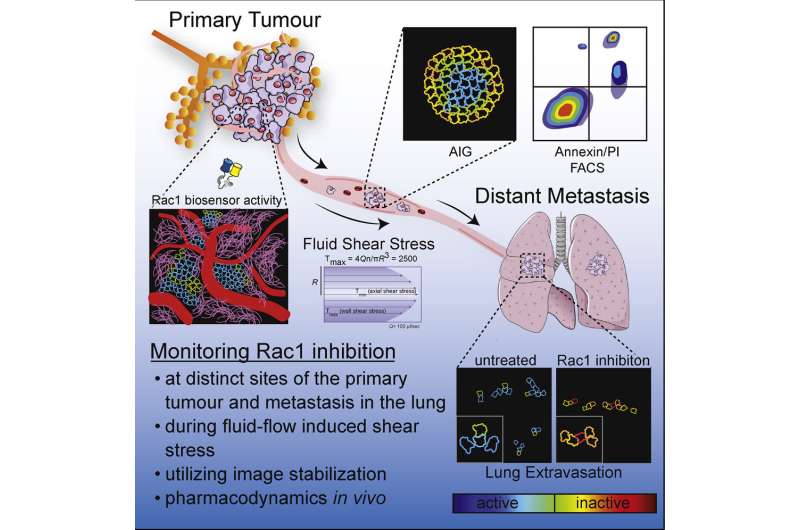Advanced imaging reveals breast cancer's Achilles' heel

For breast cancer patients, standard-of care therapies become drastically less effective if their tumor has spread to other parts of the body, such as the lung.
But a new treatment approach, investigated by a team at the Garvan Institute of Medical Research in experimental models, may help stop breast cancer cells right as they begin to spread.
"Using live imaging techniques, we were able to pinpoint a narrow window of vulnerability for metastasising breast cancers," says Professor Paul Timpson, Cancer Research Theme Leader at the Garvan Institute and co-senior author of the findings published in Cell Reports.
"For the first time, we visualized Rac1—a signaling molecule that makes breast cancer cells more resilient as they begin to travel around the body. We showed that targeting this molecule could significantly reduce breast cancer spread—a promising therapeutic approach that may build on current treatments to improve breast cancer outcomes for patients."
Capturing metastasis
Advances in breast cancer treatment and diagnostics today see 99% of patients surviving five years or longer, if their tumor is only located at its site of origin. However, this survival rate drops to 27% if the breast cancer spreads to other locations around the body.
"There is an urgent need for treatments that target breast cancer metastasis, as this has such a significant effect on patient outcomes," says Dr. Max Nobis, co-senior author of the paper.
"In our study, we investigated Rac1—a signaling molecule that normal cells produce to help control their shape and movement, but which can be co-opted by cancers to drive tumor spread."
Using intravital imaging techniques developed in-house, the team observed the activity of Rac1 deep within live tumors, tracking it as breast cancer cells metastasised.
"We found that Rac1 was most active near blood vessels or at the border of the tumor where cells were primed to move into the blood stream. Further, we discovered cancer cells could transit to different organs in clusters where Rac1 was more active at the outer surface. This helped the cancer cells be more resilient to the physical stresses that occur when cells leave a solid tumor and enter the blood stream to invade other tissues, such as the lung," says Dr. Nobis.
New approach to improve standard-of-care
When the researchers targeted Rac1 with an experimental treatment, they found that they could reduce cancer spread in their models by 73%.
"When we targeted Rac1, the breast cancer cells became more vulnerable to any shear stress they encountered in the blood stream and became far less likely to survive the journey," says Dr. Nobis.
The authors note that existing non-steroidal anti-inflammatory medications may be effective at targeting Rac1 in breast cancers. Such treatments are currently used to treat metastatic ovarian cancer, where they have been found to target Rac1 activity and prolong patient survival.
"Thanks to our imaging techniques, we were able to track the time at which inhibiting Rac1 was most effective at stopping cancer spread. Based on this data, we speculate that targeting Rac1 in combination with chemotherapy may be most effective at reducing the likelihood of cancer metastasis and recurrence," explains Dr. Nobis.
"The insights obtained in our study suggest existing treatments could be repurposed to reduce breast cancer metastasis. This could potentially fast-track the new approach to patients," says Professor Timpson.
More information: Alessia Floerchinger et al, Optimizing metastatic-cascade-dependent Rac1 targeting in breast cancer: Guidance using optical window intravital FRET imaging, Cell Reports (2021). DOI: 10.1016/j.celrep.2021.109689



















